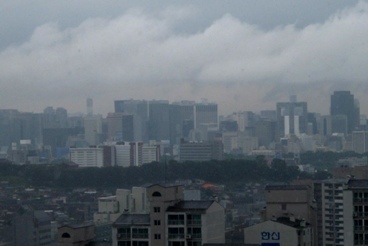The Korean Peninsula is expected to face a mega typhoon of disastrous proportions this summer, according to the state’s weather agency on Tuesday.
The Korea Meteorological Administration predicts that two or three more typhoons could hit the two Koreas up till September, after analyzing computer simulations.
The KMA found that the North Pacific high-pressure system is moving toward the peninsula and ocean temperatures off the eastern Chinese coast are rising, a possibly devastating combination.

|
(Yonhap News) |
“Through these trends, it is possible that the typhoon that will land in Korea will be even more powerful than before,” said Kim Tae-ryong, head of the KMA’s National Typhoon Center.
Through their analysis, the NTC found that during July, August and September, a total four typhoons may hit the country, up from the yearly average of two to three.
However the simulations showed that other forecasts fall within the yearly average.
The North Pacific high-pressure system is expected to spawn up to 15 typhoons this season out of 18 to 21 typhoons over the course of the year.
Typhoons, which travel along the border of the high pressure system fueled by the warm oceans, used to cross over China losing much power before hitting Korea. This would result in large amounts of rainfall over the peninsula, but little tropical storm damage.
But lately the temperature of the East China Sea has started to rise, and the North Pacific high-pressure system started to develop in a latitudinal motion rather than the normal longitudinal development.
The change in variables raises the possibility of typhoons changing their course and making landfall near the Korean Peninsula from the west coast to the south coast.
“Typhoons that have caused massive damage like “Sarah” and “Maemi” usually make landfall on the southern coast, rather than the Yellow Sea, before making its way over to the East Sea,” said Kim.
Disastrous typhoons like Sarah in 1959, Rusa in 2002 and Maemi in 2003 all had the characteristic of traveling from the south of the peninsula towards the East Sea.
The three typhoons inflicted an estimated combined property damage of $5.6 billion.
According to Kim, the ocean temperatures are high around August and September, which could bring about super typhoons.
“Even if it isn’t this year, in the future the possibility of devastation from a super typhoon is growing greater and greater,” he said.
Although typhoons act as a cleanser for the environment of sorts, Kim stressed that the appropriate educational and precautionary measures need to be placed in order to avoid human and property damage.
By Robert Lee
(robert@heraldcorp.com)
<한글 기사>
"올해 남해안 상륙 초대형 태풍 가능성"
국가태풍센터 "올 여름 태풍 2∼3개 더 온다"
제5호 태풍 '메아리'가 6월 태풍으로는 이례적 으로 우리나라에 영향을 미친 가운데 올해 여름 2∼3개의 태풍이 추가로 한반도에 영향을 미칠 것으로 전망됐다.
특히 북태평양 고기압이 남북으로 발달하고 동중국해 수온이 상승하면서 우리나 라 남해안에 직접 상륙하는 초대형 태풍 내습 가능성이 있는 것으로 분석됐다.
기상청 국가태풍센터는 2011년 여름철(7, 8, 9월) 태풍 전망에서 태풍 계절예측 역할모델을 통해 분석한 결과 이렇게 나타났다고 12일 밝혔다.
태풍센터는 7∼9월 북서태평양 태풍 발생건수가 13∼15개로 평년과 비슷할 것으 로 전망했다.
연말까지는 평년(21.5개)과 비슷하거나 조금 적은 18∼21개의 태풍이 발생할 것 으로 분석했다.
그러나 우리나라에 영향을 미치는 태풍은 당초 2∼3개에서 최대 4개로 늘어날 것으로 관측됐다.
김태룡 국가태풍센터장은 "지난 6월 서해안으로 지나간 5호 태풍 '메아리' 외에 9월까지 2∼3개가 추가로 우리나라에 영향을 미칠 가능성이 높다"면서 "이는 5월 당 시의 전망 보다 1개 정도 많아진 수치"라고 설명했다.
특히 태풍을 둘러싼 북태평양 고기압의 발달 정도와 해수면 온도 변화 등의 요 인이 겹치면서 초대형 태풍 내습 가능성이 높아지고 있다.
태풍은 보통 북태평양 고기압의 가장자리를 따라 이동하면서 해양으로부터 에너 지를 받게 된다.
그동안 우리나라에 영향을 미치던 태풍은 보통 중국을 지나면서 세력이 약화돼 열대저기압화되는 경우가 많았다.
이 경우 우리나라 중부 지방에 간접적으로 비를 뿌리면서 호우주의보가 발효되 는 경우는 있었지만 직접적인 피해는 크지 않았다.
그러나 최근 태풍 이동경로인 동중국해 수온이 상승하면서 해양으로부터 많은 에너지를 받을 가능성이 높은데다 북태평양 고기압이 예년처럼 동서가 아닌 남북으 로 발달하면서 태풍이 서해안이 아닌 남해안으로 직접 상륙할 가능성이 높아지고 있 다는 설명이다.
김 센터장은 "남해안으로 바로 들어온다는 것은 태풍이 에너지를 소모하지 않고 그대로 유지한 채 온다는 뜻"이라며 "특히 수온이 높고 대양 에너지가 가장 많은 8 ∼9월에 남해안에 상륙하면 태풍 '사라'나 '루사' 처럼 큰 피해를 불러올 수 있다" 고 강조했다.
김 센터장은 "올해가 아니더라도 앞으로 강력한 태풍의 내습 가능성이 점점 더 커지고 있다"면서 "태풍 피해를 최소화하기 위한 사전 노력이 중요하다"고 당부했다. (연합뉴스)







